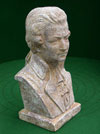3D Modelling
The ever
increasing need for 3D models in robotics and Virtual Reality/Augmented Reality
applications require a closer look at this widespread research field. The
prerequisites range from fast, i.e. online, model generation, highly
accurate models for collision detection and avoidance to photo-realistic models
used in VR, i.e. telepresence and tele-operation scenarios. To gain the
appropriate model for the desired application, a wide range of sensors and
several data processing steps are necessary.
 |
Stereo Image Algorithms
Ordinary
cameras capture images by projecting light of a three dimensional
scene onto a two dimensional plane (i.e. the image plane). Due to
this process, one dimension is lost. This dimension is the depth of
an image, i.e. the distance between the camera and objects in the
scene. |
Full article |
|
 |
Online Surface Reconstruction
The
development of range sensors allows for generating 3D models by
contact-less measurement of the desired objects surface. These
models can be used for virtual reality applications, like virtual
museums or product presentations, but also for path planning and
collision avoidance in the robotic field. |
Full article |
|
 |
Texture Mapping
Texture mapping
adds a (photo-)realistic impression to a give n 3-D model by linking
each surface path of the model with an image, called texture. Often,
pre-defined, synthetic textures are used for the 3-D models. Here,
the real texture of the model is gathered by moving a camera around
the real object in question. |
Full article |
|
 |
Autonomous C-Space Exploration and Object
Inspection
The Multisensory 3D-Modeller, developed at
the Institute of Robotics and Mechatronics, acquires 3-D information
about the environment. This device consists of a 7-dof passive
manipulator mounted with four different types of sensors: a
light-stripe sensor, a laser-range scanner, a passive stereo vision
sensor, and a texture sensor. |
Full article |
|
|
|